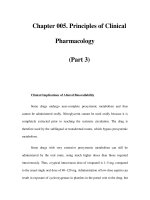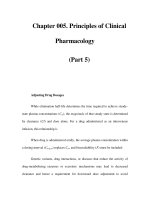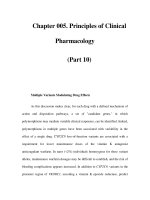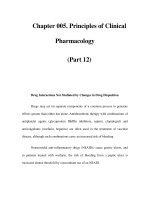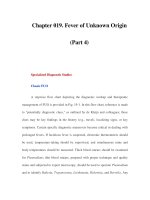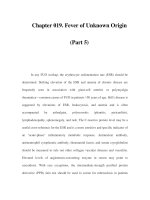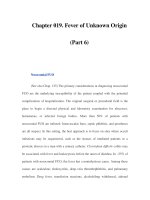Chapter 019. Fever of Unknown Origin (Part 5) doc
Bạn đang xem bản rút gọn của tài liệu. Xem và tải ngay bản đầy đủ của tài liệu tại đây (14.65 KB, 5 trang )
Chapter 019. Fever of Unknown Origin
(Part 5)
In any FUO workup, the erythrocyte sedimentation rate (ESR) should be
determined. Striking elevation of the ESR and anemia of chronic disease are
frequently seen in association with giant-cell arteritis or polymyalgia
rheumatica—common causes of FUO in patients >50 years of age. Still's disease is
suggested by elevations of ESR, leukocytosis, and anemia and is often
accompanied by arthralgias, polyserositis (pleuritis, pericarditis),
lymphadenopathy, splenomegaly, and rash. The C-reactive protein level may be a
useful cross-reference for the ESR and is a more sensitive and specific indicator of
an "acute-phase" inflammatory metabolic response. Antinuclear antibody,
antineutrophil cytoplasmic antibody, rheumatoid factor, and serum cryoglobulins
should be measured to rule out other collagen vascular diseases and vasculitis.
Elevated levels of angiotensin-converting enzyme in serum may point to
sarcoidosis. With rare exceptions, the intermediate-strength purified protein
derivative (PPD) skin test should be used to screen for tuberculosis in patients
with classic FUO. Concurrent control tests, such as the mumps skin test antigen
(Aventis-Pasteur, Swiftwater, PA), should be employed. It should be kept in mind
that both the PPD skin test and control tests may yield negative results in miliary
tuberculosis, sarcoidosis, Hodgkin's disease, malnutrition, or AIDS.
Noninvasive procedures should include an upper gastrointestinal contrast
study with small-bowel follow-through and colonoscopy to examine the terminal
ileum and cecum. Colonoscopy is especially strongly indicated in the elderly.
Chest x-rays should be repeated if new symptoms arise. Sputum should be induced
with an ultrasonic nebulizer for cultures and cytology. If there are pulmonary signs
or symptoms, bronchoscopy with bronchoalveolar lavage for cultures and cytology
should be considered. High-resolution spiral CT of the chest and abdomen should
be performed with both IV and oral contrast. If a spinal or paraspinal lesion is
suspected, however, MRI is preferred. MRI may be superior to CT in
demonstrating intraabdominal abscesses and aortic dissection, but the relative
utility of MRI and CT in the diagnosis of FUO is unknown. At present, abdominal
CT with contrast should be used unless MRI is specifically indicated.
Arteriography may be useful for patients in whom systemic necrotizing vasculitis
is suspected. Saccular aneurysms may be seen, most commonly in renal or hepatic
vessels, and may permit diagnosis of arteritis when biopsy is difficult.
Ultrasonography of the abdomen is useful for investigation of the hepatobiliary
tract, kidneys, spleen, and pelvis. Echocardiography may be helpful in an
evaluation for bacterial endocarditis, pericarditis, nonbacterial thrombotic
endocarditis, and atrial myxomas. Transesophageal echocardiography is especially
sensitive for these lesions.
Radionuclide scanning procedures using technetium (Tc) 99m sulfur
colloid, gallium (Ga) 67 citrate, or indium (In) 111–labeled leukocytes may be
useful in identifying and/or localizing inflammatory processes. In one study, Ga
scintigraphy yielded useful diagnostic information in almost one-third of cases,
and it was suggested that this procedure might actually be used before other
imaging techniques if no specific organ is suspected of being abnormal. It is likely
that PET scanning, which provides quicker results (hours vs days), will prove even
more sensitive and specific than
67
Ga scanning in FUO.
99m
Tc bone scan should be
undertaken to look for osteomyelitis or bony metastases;
67
Ga scan may be used to
identify sarcoidosis (Chap. 322) or Pneumocystis infection (Chap. 200) in the
lungs or Crohn's disease (Chap. 289) in the abdomen.
111
In-labeled white blood
cell (WBC) scan may be used to locate abscesses. With these scans, false-positive
and false-negative findings are common. Fluorodeoxyglucose F18 (FDG) PET
scanning appears to be superior to other forms of nuclear imaging. The FDG used
in PET scans accumulates in tumors and at sites of inflammation and has even
been shown to accumulate reliably at sites of vasculitis. Where available, FDG
PET scanning should therefore be chosen over
67
Ga scanning in the diagnosis of
FUO.
Biopsy of the liver and bone marrow should be considered in the workup of
FUO if the studies mentioned above are unrevealing and if fever is prolonged.
Granulomatous hepatitis has been diagnosed by liver biopsy, even when liver
enzymes are normal and no other diagnostic clues point to liver disease. All biopsy
specimens should be cultured for bacteria, mycobacteria, and fungi. Likewise, in
the absence of clues pointing to the bone marrow, bone marrow biopsy (not simple
aspiration) for histology and culture has yielded diagnoses late in the workup.
When possible, a section of the tissue block should be retained for further sections
or stains. PCR technology makes it possible in some cases to identify and speciate
mycobacterial DNA in paraffin-embedded, fixed tissues at some research centers.
Thus, in some cases, a retrospective diagnosis can be made on the basis of studies
of long-fixed pathologic tissues. In a patient over age 50 (or occasionally in a
younger patient) with the appropriate symptoms and laboratory findings, "blind
biopsy" of one or both temporal arteries may yield a diagnosis of arteritis.
Tenderness or decreased pulsation, if noted, should guide the selection of a site for
biopsy. Lymph node biopsy may be helpful if nodes are enlarged, but inguinal
nodes are often palpable and are seldom diagnostically useful.
Exploratory laparotomy has been performed when all other diagnostic
procedures fail but has largely been replaced by imaging and guided-biopsy
techniques. Laparoscopic biopsy may provide more adequate guided sampling of
lymph nodes or liver, with less invasive morbidity.

